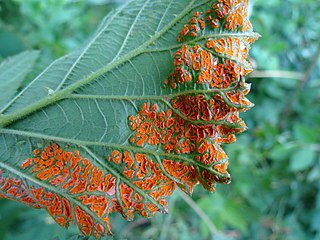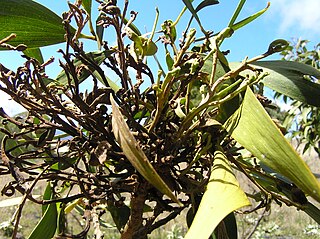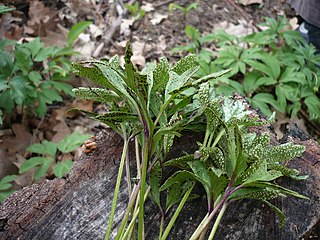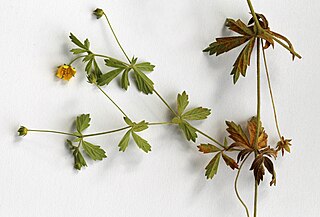
Hiratsuka is a city in Kanagawa Prefecture, Japan. As of 1 April 2021, the city had an estimated population of 257,316 and a population density of 3800 persons per km². The total area of the city is 67.88 square kilometres (26.21 sq mi).

Shonan Bellmare is a Japanese professional football club based in Hiratsuka, in the west of Kanagawa Prefecture, part of the Greater Tokyo Area. The club plays in the J1 League, which is the top tier of football in the country. Their home stadium is Hiratsuka Athletics Stadium. Shonan refers to a coastal area along Sagami Bay that includes Hiratsuka. Bellmare is a portmanteau of the Italian words bello and mare, meaning "beautiful sea".

The Cronartiaceae are a family of rust fungi in the order Uredinales.

Cronartium is a genus of rust fungi in the family Cronartiaceae.

Arthuriomyces peckianus is a fungal plant pathogen, which causes orange rust on members of the genus Rubus, and various species of berries. It is found in central and eastern North America, and Eurasia.

Puccinia is a genus of fungi. All species in this genus are obligate plant pathogens and are known as rusts. The genus contains about 4000 species.
Vladimir Andreevich Tranzschel was a Russian and later Soviet botanist, mycologist and plant pathologist, especially an expert on rust fungi.

The Pileolariaceae are a family of rust fungi in the order Pucciniales. A 2008 estimate places contains 4 genera and 34 species in the family.

The Uropyxidaceae are a family of rust fungi in the order Pucciniales. The family contains 15 genera and 149 species.
This article documents statistics from the Emperor's Cup of the 1994 season.
1994 Bellmare Hiratsuka season
1995 Verdy Kawasaki season
1995 Bellmare Hiratsuka season
1996 Bellmare Hiratsuka season

Arthuriomyces is a genus of rust fungi in the family Phragmidiaceae. The genus contains three species that are found in North America, Russia, China, and Japan. The genus is named in honor of American botanist Joseph Charles Arthur, noted for his research on rust fungi.

Frommeella (Frommeëlla) is a genus of rust fungi in the family Phragmidiaceae. The widespread genus contains two species.
George Baker Cummins was a notable American mycologist and was considered an authority on the rust fungi. At his death he was the last surviving charter member of the Mycological Society of America.

Pine-pine gall rust, also known as western gall rust, is a fungal disease of pine trees. It is caused by Endocronartium harknessii, an autoecious, endocyclic, rust fungus that grows in the vascular cambium of the host. The disease is found on pine trees with two or three needles, such as ponderosa pine, jack pine and scots pine. It is very similar to pine-oak gall rust, but its second host is another Pinus species. The fungal infection results in gall formation on branches or trunks of infected hosts. Gall formation is typically not detrimental to old trees, but has been known to kill younger, less stable saplings. Galls can vary from small growths on branch extremities to grapefruit-sized galls on trunks.
The spruce cone rust, caused by the rust fungus Chrysomyxa pirolata Wint., affects spruces in 3 continents, including white spruce in Canada. Alternate hosts of the fungus are several species among 3 genera of wintergreen: Pyrola spp., Orthilia spp., and Moneses spp.. Diseased cones open prematurely and orange-yellow aeciospores are sometimes produced in such quantity as to color the forest floor and lake surfaces. Up to half of a cone crop can be affected, and most of the affected cones do not produce viable seed. Some localities commonly experience damage to 20% to 30% of cone crops, a factor to be considered in the siting of seed orchards.

The Zaghouaniaceae are a family of rust fungus genera, some of which have long been considered incertae sedis in the order Pucciniales, based on the type genus Zaghouania. The classification of fungal taxa based on only morphological characteristics has long been recognised as problematical, so this order was reviewed over a long-term study using three DNA loci and published in 2021.











